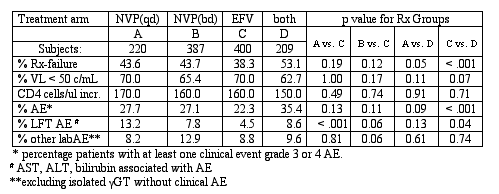 |
 |
 |
| |
N-N-N-Non-nucleosides: one, the other, or both?
Reported by David Margolis, MD, University of Texas, Southwestern Medical Center
|
| |
| |
The "2NN" study compared initial regimens that contained nevirapine once or twice a day with an efavirenz regimen, and a combo NVP/EFV regimen. 1,216 therapy naive patients to NVP once daily (qd), NVP twice daily (bid), EFV or NVP (qd) + EFV. The NRTI backbone consisted of d4T and 3TC, but could be changed for toxicity reasons. Primary endpoint: percentage of patients with treatment failure (Rx-failure), defined as either less than 1 log decline in plasma HIV-1 RNA in the first 12 weeks, virologic failure from week 24 onwards, disease progression, or change of allocated treatment. All analyzes were at wk 48 for the intention to treat population (all randomized patients). Baseline characteristics were similar for all 4 arms, including prevalence of hepatitis virus co-infections.
|
|
| |
 |
|
| |
The only significant difference found in the study was in therapy failure when the efavirenz arm was compared to the combination efavirenz/nevirapine arm, caused primarily by increased treatment discontinuations in the combination arm. The incidence of clinical adverse events did not differ significantly between the single nNRTI arms. The incidence of liver associated laboratory AEs was higher in the NVP (qd) arm when compared to efavirenz. The lipid effects of these regimens were presented in poster 752, showing marginally worse effects on triglycerides, cholesterol and Chol./HDL ratio for the dual NNRTI arm, and marginally better ones for the NVP arm.
This study was anchored by the comparator arm of D4T/3TC/efavirenz, which some would argue is a reasonable surrogate for the current standard of care (although currently concerns about D4T might drive one to choose another nucleoside). Therefore these findings suggest that nevirapine either qd or bid is a reasonable alternative to efavirenz, if a modestly elevated rate of hepatic events can be accepted. This may be reasonable, particularly in cases in which side effects of efavirenz are difficult to manage. As presented by Mayers this summer in Barcleona, rare, idiosyncratic severe hepatotoxicity occurs nearly exclusively in the first 6 weeks of nevirapine therapy. Other liver-related events thought to be due to nevirapine can be managed clinically. Dual NNRTIs appear to offer no advantage.
|
|
| |
|
 |
 |
|
|